
Two charges, -Q and -3Q, are a distance apart. These two charges are free to move but do not because there is a third (fixed) charge nearby. What must be the magnitude of the third charge and its placement in order for the first two to be in equilibrium?

In order to watch this solution you need to have a subscription.
This is Giancoli Answers with Mr. Dychko. This charge negative three Q naught is placed here, and some other charge negative Q naught is over here. We know that they're repelling each other because they have the same sign, they're both negative. We also know that they're not moving despite being otherwise free to move because there's some other charge placed somewhere that holds them in their positions. So, it must mean that there's some positive charge placed between them to compensate for their repulsion. So the two charges in black are repelling each other like this, and so there must be a positive charge in between to provide a compensating attractive force in this direction, so that the net force on both charge negative Q naught and negative three Q naught are zero. I mean if some positive charges are placed out here, then it would attract this one even more and move it even more in this direction than it already is being forced in that direction by the repulsion from this charge. So that's not gonna work. Then you can try putting a positive charge over here and likewise this one we get moved even more to the left that it already is, due to the repulsion from this charge. The only place that works is in between them. Now, the next question is, well, what should the magnitude of this charge be, and what should its position be exactly. So if some distance, x, from the charge negative Q naught and there'll be some distance here from the charge negative three Q naught, and we know the total separation is l so that makes this distance here a total l minus x. Let's consider the left-hand charge here first of all. So we have the electrostatic repulsion between this charge and this charge is kQ naught times three Q naught over the distance separating them l squared. And because this charge has a net force of zero on it, that means the attractive force between these two charges is equal and so that's kQ naught times whatever Q is, divided by that separation between them, x squared. Likewise, we know that the repulsive force on this charge, which is the same as the repulsive force on this charge. So those two things are equal. That has to equal the force of attraction between these two charges which is k times three Q naught times Q over their separation which is l minus x squared. Because each of these things equals the same thing here, these two are equal to each other which is whatever in here. Now, the job is to do some algebra to solve for x. So the ks cancel and the Q naughts cancel, and so are the Qs. So that's nice. We're left with one over x squared, is three over l minus x squared. You could take the reciprocal of both sides, and that gives you x squared is l minus x squared over three. And then multiply both sides by three. And you end up with this line here after you switch the sides around as well. So you have l minus x all squared equals three x squared. And then take the square root of both sides, and you get l minus x equals square root three times x. Let's take this to right-hand side. Factor out the common factor, x, and you get x times one plus square root of three equals l, and then divided by this bracket, and now finally, we have x in terms of l. So, x is l over one plus square root three, which is .336 times l. That gives us the position of this unknown charge. It's some distance .33 or .366l from the left-hand charge, then we'll figure out its magnitude of the charge. So substituting into either one of these equations, it doesn't matter which one. I think I chose the first one here. We're gonna solve for Q. We have kQ naught times three Q naught over l squared is kQ naughtQ over x squared. Replacing with .366l, we can solve for Q now. The kQ naught cancel, but this one doesn't. The l squared cancel, and we're left with 0.366 squared. And when you multiply both sides by .366 squared, you get Q equals .13397 times three Q naught. So this is .3666, square root here. That makes it a .40192 times Q naught. And here we have the answer then, it's Q is .4 times Q naught had a position .37l from Q naught between the charges.
It seems that there is a small typo in your answer for the location for the charge. In the video you say that the location is .37l, not .27l. (~4:10 in video)
Hi williams.dpw, thank you very much for spotting that. I have updated the quick answer.
All the best,
Mr. Dychko
I thought if the charges were repelling each other, we draw the lines towards the charge they are repelling- like a "push". Why is it different here?
I now understand what you did with the vectors. However, now my question is why do we multiply the .13397 *3Q? Isn't 3Q an identification? I would have thought that the answer would be .13397 of 3Q= Q. Can you explain to me why this incorrect?